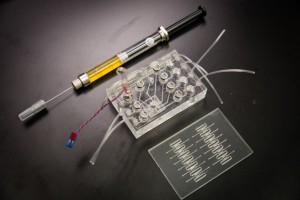Researchers’ prototype uses lab-on-a-chip technology and seems to do it all, from collection and analysis to results in minutes and in the palm of your hand
Here’s a diagnostic workhorse that can also easily slip inside the pocket of a doctor’s white coat. The slim device, created and reported by researchers, integrates a clinical laboratory’s workflow from collecting samples to analyzing them and reporting results in minutes.
The device is dubbed “lab in a needle” by researchers at Houston Methodist and their collaborators at Singapore’s Nanyang Technological University (NTU) and the Singapore Institute of Manufacturing Technology (SIMTech). The recently announced study focused on liver toxicity. But the research team says in a news statement that their medical laboratory-in-a-needle has potential to diagnose and monitor therapies for many health conditions in settings well beyond the medical laboratory and hospital.
For clinical laboratory leaders and pathologists, the prototype can be seen as another step forward in efforts to develop more sophisticated point-of-care testing (POCT) that incorporate miniature lab-on-a-chip (LOC) technologies. Mass production could bring the tiny mobile lab’s capabilities to remote and rural communities where low cost and ease of use are essential.
A Research Goal to Integrate Medical Lab Processes in a POCT Device
Researchers were on a mission to fill a gap they perceived in POCT. So they aimed their study on creation of a mobile, miniature clinical laboratory to handle the entire diagnostic process from “sample-in” to “answer-out.”
“The reported microfluidic devices for POCT hepatotoxicity assessment remain rudimentary as they largely embody only semi-quantitative or single sample/gene detection capabilities,” the researchers wrote in an article about the invention published in the Royal Society of Chemistry’s (RSC) online publication Lab on a Chip.
“We describe, for the first time, an integrated LOC system that is somewhat close to a practical POCT hepatotoxicity assessment device … it has ‘sample-in-answer-out’ capabilities for multiplex gene expression analysis,” said the RSC researchers in their paper.

Stephen Wong, PhD, is Chair of the Department of Systems Medicine and Bioengineering at Houston Methodist Research Institute. He said that, in creating “lab in a needle,” his team used lab-on-a-chip technology to collapse medical laboratory functions on a microfluidics chip. “Our goal is to integrate sample acquisition and preparation into one device, a significant challenge that has slowed the development of point-of-care testing,” he said in a statement about the research. (Photo copyright: Houston Methodist.)
From Collection to Results in the Field in 30 Minutes
The lab-in-a-needle device detects liver toxicity in 30 minutes as compared to several days (required by multiple steps) in current liver toxicity testing, according to the news statement. Liver function tests to identify ALT and AST enzymes are often used by physicians to ascertain effects of chemotherapy on their patients. The device proved effective in detecting liver toxicity in mice (some were induced with it as part of the research and others were not).
“It really integrates the whole laboratory process in one testing without any human in between,” said Stephen Wong, PhD, Chair of the Department of Systems Medicine and Bioengineering at Houston Methodist Research Institute, in an article about the new technology in Inside Science. “This is [a] change in [the] paradigm—a really disruptive technology. You are no longer tied down to the lab [to carry out diagnostic procedures],” Wong continued.

The lab-in-a-needle device (pictured above) involves two chips. One has a miniature motor and microfluidics to handle sample preparation. The other chip amplifies the samples, according to researchers at Houston Methodist, who collaborated with Nanyang Technological University (NTU) and the Singapore Institute of Manufacturing Technology (SIMTech), two major Singapore institutions, to develop the device. The portable lab-in-a-needle instrument could make possible instant results from routine lab tests, the organizations’ research suggests. (Photo copyright: Houston Methodist.)
Microfluidics and Miniature Motor Used with the Lab-On-a-Chip Device
So how does lab-in-a-needle work? Researchers placed a chip, featuring microfluidics and a miniature motor, inside the prototype device. The sample was prepared within the device, making quick analysis possible. Researchers noted that another connected chip amplified the sample to help ensure accuracy of results.
As to how liver samples were analyzed, a Gizmag article detailed these device capabilities:
1) DNA components are refined and extracted as samples are ground up;
2) A separate part of the device puts them into test wells and performs toxicity tests;
3) Images of each test well are recorded by a camera; and,
4) Images help technicians find evidence of toxic concentrations.
“What we have proven is when the doctor takes a blood or liver sample, the sample can be prepared and analyzed using lab-on-a-chip methods, which eliminates the need for wet laboratory work and experts. Our method significantly reduces time, manpower and costs, and yet has the same accurate results,” said Joseph Chang, PhD, a Professor of Circuits and Systems who is Director of Virtus, the IC Design Centre of Excellence at NTU.
Big Plans for a Small “Lab-on-a-Chip”
Next steps reported by the research team involve integrating the sample preparation and analysis chips into one device, testing on humans, exploring other tissues and body fluids, and possibly tapping A*STAR SIMTech’s manufacturing capabilities to cost effectively scale the device for mass production.
But this is not the first time Dark Daily readers have heard researchers rave about lab-on-a-chip’s potential. About a year ago, Dark Daily covered a new nanotechnology that made it possible for a team at Stanford University School of Medicine to develop a medical laboratory test for type-1 diabetes that can be performed in a physician’s office and does not require a specimen collected by venipuncture. (See “Nanotechnology-Based Medical Laboratory Test Chip Developed at Stanford University Detects Type-1 Diabetes in Minutes and Can Be Used in Doctors’ Offices,” November 14, 2014.)
The team there found processing time, using the chip (coated with an array of nanoparticle-sized islands of gold), takes about an hour as compared to days associated with conventional testing using radioactive materials and requiring trained laboratory professionals. Sound familiar?
And more recently, an October Dark Daily e-briefing explored research on implantable chips aimed at continuous patient monitoring and transmitting data in real-time to providers and labs.
Continuing Efforts to Produced ‘Medical Laboratory-on-a-Chip’ for Clinical Use
Clearly, pathologists and laboratory leaders will want to stay abreast of developing mobile technology to enable new possibilities for diagnosis and results reporting as well as care monitoring.
Among the challenges to consider relative to the lab-in-a-needle, and perhaps other developing inventions, is tracking the data they capture and report. After all, as new technology surfaces and succeeds, the traditional lab needs to continue to be a reliable source of diagnostics data that can be appropriately used and coordinated to improve patient care and reduce costs.
—Donna Marie Pocius
Related Information:
Prototype Lab in a Needle Could Make Real-Time, Mobile Laboratory Testing a Reality
Laboratory in a Needle Promises Rapid Diagnosis
Researchers Create “Lab in a Needle”
“Lab in a Needle” Could Streamline Medical Diagnoses
Prototype Lab in a Needle Could Make Real-Time, Mobile Laboratory Testing a Reality



